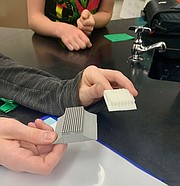Middle school team takes second in national Youth Design Challenge
It’s a bird! It’s a plane! It’s biomimicry!
A team of Kalispell Middle School seventh-graders took second place in the middle school category of the Biomimicry Youth Design Challenge, which asks students to find inspiration in nature to engineer designs that solve or mitigate problems. The team included Jayson Aurand, Brodyn DeShaw, Zavier Innerbichler and Parker Miller.
For the national challenge, organized by the Missoula-based nonprofit, Biomimicry Institute, students chose a problem to solve or mitigate by combining the biological strategies of a minimum of two organisms into one design. Students also submitted two-minute video pitches and project portfolios.
“If you really think about it, plants and animal life has been on the Earth for millions and millions of years and they’ve evolved in certain ways to help solve problems that we have today,” Innerbichler said.
For the Kalispell seventh-graders, the brainstorming process started with looking at the chemicals in ice-melting products and the harm they cause to dogs' paws.
“When we looked more into it we found out about how harmful ice melt is to the environment and we wanted to find a way to have a better way to deal with ice on sidewalks,” Innerbichler said.
Their research dive then led them to learn about chemical compounds used to de-ice aircraft and its effect on the environment.
“We found out when they put it on plane wings, so it doesn’t get iced over, it will come off and go into the environment,” DeShaw said, ending up in soil and groundwater.
THE GROUP of four decided to try and come up with a more sustainable design for airplane wings. Then they sought out what biological organisms had ice-resistant qualities that could be used as the basis for designing something more environmentally friendly, according to Aurand, and learned about the frost-resistant surface of mint leaves on asknature.org, which used academic research from Northwestern University.
“And that’s where we got started,” Aurand said.
Then, they found some research on the water-repellent surface of cicada wings.
“We wanted to find a way to incorporate both cicada wings and mint leaves into a design,” Innerbichler said.
They also looked into pine needles and how less surface area could improve ice resistance.
Miller brought out their two design prototypes, one they used as their final submission. It features compact rows of raised, solid cylindrical columns with a flat sloping border.
Then, they made a 3D printed model, took it outside during winter, sprayed water on it and waited 20 minutes.
The group wants to continue improving the design to enter future competitions and already have more questions they want to find the answers to including how to incorporate it into a real-life setting in a cost-efficient way. Another question they had in talking about cost efficiency is whether the design should be a material that is added to a plane wing or if it should be incorporated into the wing design during the manufacturing process.
This is the second year students have entered the challenge said KMS science teacher Annie Gustafson. The students also worked on their project portfolios, pitch videos and created websites in English and language arts with teacher Ashley Anderson.
Gustafson said it’s an opportunity to engage young students in the scientific and engineering process and study of evolution.
“The process starts by asking a question [and] defining a problem. We spent a couple of days talking about problems in our community and world problems,” Gustafson said.
Next, students developed designs and models using Tinkercad software and 3D printers.
“I think this is one of the hardest problems you can do because a lot of times in science we’re following protocols. We’re following step-by-step procedures and we’re doing experiments that we already know the outcomes do, but this is an original project, so being able to come up with your own model is a really hard thing to do,” Gustafson said.
A total of five projects completed by 19 KMS students were entered into the challenge. The projects were possible through a $1,928 Kalispell Education Foundation grant.
“It’s pretty impressive for a group of seventh-graders to come up with a problem. Come up with a biomimicry solution, design a model, test your model, build a portfolio, website, and finally, a pitch video. They did that in six weeks,” Gustafson said.
For more information on the challenge and winners visit biomimicry.org.
Reporter Hilary Matheson may be reached at 406-758-4431 or by email at hmatheson@dailyinterlake.com.



